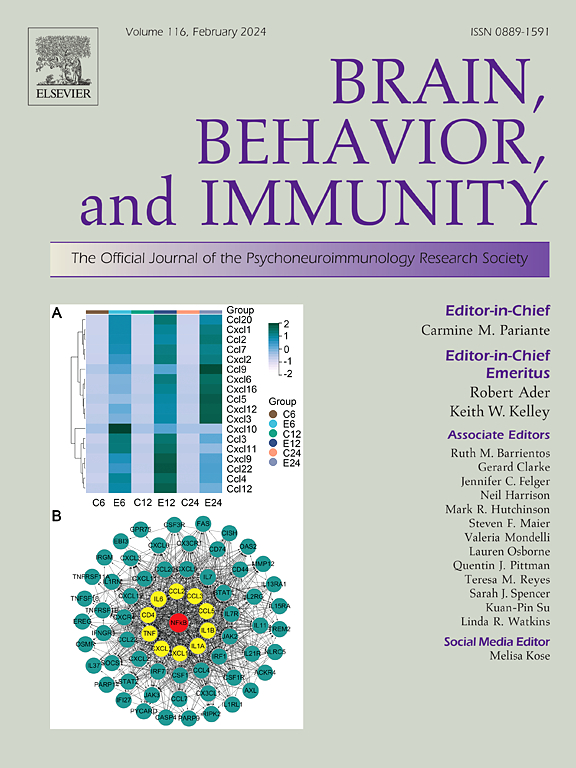Transcriptional signature of a hypersensitive glucocorticoid receptor variant in the neuroendocrine system suggests enhanced vulnerability to brain disorders
IF 8.8
2区 医学
Q1 IMMUNOLOGY
引用次数: 0
Abstract
The natural substitution Ala610Val in the porcine glucocorticoid receptor (GRAla610Val) leads to a profound compensatory downregulation of the hypothalamic–pituitary–adrenal (HPA) axis in early ontogeny. In this study, we leveraged this unique animal model to explore mechanisms of HPA axis regulation and consequences of its genetically-based persistent hypoactivity. To this end, we examined transcriptional signature of GRAla610Val in the hypothalamus, hippocampus, amygdala and adrenal gland in resting conditions (i.e. baseline glucocorticoid level) using mRNA sequencing. In addition, we studied transcriptome responses to two different doses of dexamethasone in the hypothalamus and hippocampus, depending on GRAla610Val. Across tissues, GRAla610Val consistently influenced the expression of several clustered protocadherins, particularly PCDHB7. Clustered protocadherins play an important role in neuronal connectivity and are implicated in different neurobiological disorders. Moreover, in line with our previous findings in blood immune cells, we found higher expression of pro-inflammatory genes, including canonical members of the TLR4 signaling pathway, in the brain of Val carriers. While the pro-inflammatory priming occurs already at resting conditions in the amygdala, in hypothalamus and hippocampus this seems to be associated with a stronger downregulation of several marker genes of homeostatic microglia, such as SALL1, by dexamethasone in Val carriers. Regarding the regulation of the HPA axis, GRAla610Val showed a dose-dependent effect on the central regulator of the axis, CRH, suggesting a dynamic adaptation to the glucocorticoid hypersensitivity of the Val variant. In the adrenal gland, GRAla610Val appears to downregulate cortisol production by impairing mitochondrial function. Overall, the transcriptional signature of GRAla610Val provides strong evidence that GR hypersensitivity leads to increased susceptibility to brain disorders.
神经内分泌系统中糖皮质激素受体超敏变体的转录特征表明更易患脑部疾病。
猪糖皮质激素受体(GRAla610Val)的自然替代Ala610Val在个体发育早期导致下丘脑-垂体-肾上腺(HPA)轴的深度代偿性下调。在这项研究中,我们利用这种独特的动物模型来探索下丘脑轴的调节机制及其基于基因的持续性低活动的后果。为此,我们利用mRNA测序技术检测了静息条件下(即糖皮质激素基线水平)下丘脑、海马、杏仁核和肾上腺中GRAla610Val的转录特征。此外,我们研究了下丘脑和海马对两种不同剂量地塞米松的转录组反应,这取决于GRAla610Val。在组织中,GRAla610Val持续影响几种聚集性原钙粘蛋白的表达,尤其是PCDHB7。簇状原钙粘蛋白在神经元连接中起重要作用,并与不同的神经生物学疾病有关。此外,与我们之前在血液免疫细胞中的发现一致,我们发现促炎基因的表达更高,包括TLR4信号通路的典型成员,在Val携带者的大脑中。虽然促炎启动在静息状态下已经在杏仁核中发生,但在下丘脑和海马体中,这似乎与Val携带者地塞米松对稳态小胶质细胞的几个标记基因(如SALL1)的较强下调有关。在HPA轴的调控方面,GRAla610Val对HPA轴的中枢调控因子CRH表现出剂量依赖性,提示其对Val变异体糖皮质激素超敏反应的动态适应。在肾上腺中,GRAla610Val似乎通过损害线粒体功能下调皮质醇的产生。总的来说,GRAla610Val的转录特征提供了强有力的证据,表明GR超敏性导致对脑部疾病的易感性增加。
本文章由计算机程序翻译,如有差异,请以英文原文为准。
求助全文
约1分钟内获得全文
求助全文
来源期刊
CiteScore
29.60
自引率
2.00%
发文量
290
审稿时长
28 days
期刊介绍:
Established in 1987, Brain, Behavior, and Immunity proudly serves as the official journal of the Psychoneuroimmunology Research Society (PNIRS). This pioneering journal is dedicated to publishing peer-reviewed basic, experimental, and clinical studies that explore the intricate interactions among behavioral, neural, endocrine, and immune systems in both humans and animals.
As an international and interdisciplinary platform, Brain, Behavior, and Immunity focuses on original research spanning neuroscience, immunology, integrative physiology, behavioral biology, psychiatry, psychology, and clinical medicine. The journal is inclusive of research conducted at various levels, including molecular, cellular, social, and whole organism perspectives. With a commitment to efficiency, the journal facilitates online submission and review, ensuring timely publication of experimental results. Manuscripts typically undergo peer review and are returned to authors within 30 days of submission. It's worth noting that Brain, Behavior, and Immunity, published eight times a year, does not impose submission fees or page charges, fostering an open and accessible platform for scientific discourse.

 求助内容:
求助内容: 应助结果提醒方式:
应助结果提醒方式:


